A possible forerunner to a future molecular assembly line uses an artificial DNA motor to transport an artificial nanoparticle along a carbon nanotube track.
Integrating DNA nanotechnology and RNA to transport nanoparticles along nanotubes


A possible forerunner to a future molecular assembly line uses an artificial DNA motor to transport an artificial nanoparticle along a carbon nanotube track.

A recently released technology report titled Nano-solutions for the 21st century outlines nanotech-based solutions to global challenges. Several years in the making, the report was co-authored by Dennis Pamlin, Research Fellow at the Chinese Academy of Social Sciences Research Center for Sustainable Development (RCSD web site currently in Chinese only), and Eric Drexler, Academic Visitor… Continue reading New Report: Nano-solutions for the 21st century

A major advance in the computational design of proteins that bind tightly to specific small molecules will facilitate several technologies, possibly including the development of atomically precise manufacturing.

In two different sets of experiments a German research group has shown that scaffolded DNA origami can be used to assemble complex structures with precise sub-nanometer positional control, and that constant temperature reaction can greatly increase yields and decrease production times.

Two types of biological molecular motors that run in opposite directions along a protein track can be used in different arrangements to either move a complex DNA cargo along the track or engage in a tug-of-war.
Large molecular cages constructed from metal-organic frameworks have set a record for the greatest surface area in the least mass.
Metal-organic frameworks (MOFs) are back in the news again. A few months ago we cited the use of MOFs by Canadian chemists to self-assemble a molecular wheel on an axis in a solid material. More recently chemists at Northwestern University have used MOFs to set a world record for surface area. From “A world record for highest-surface-area materials“:
Northwestern University researchers have broken a world record by creating two new synthetic materials with the greatest amount of surface areas reported to date.
Named NU-109 and NU-110, the materials belong to a class of crystalline nanostructure known as metal-organic frameworks (MOFs) that are promising vessels for natural-gas and hydrogen storage for vehicles, and for catalysts, chemical sensing, light harvesting, drug delivery, and other uses requiring a large surface area per unit weight.
The materials’ promise lies in their vast internal surface area. If the internal surface area of one NU-110 crystal the size of a grain of salt could be unfolded, the surface area would cover a desktop. …
MOFs are composed of organic linkers held together by metal atoms, resulting in a molecular cage-like structure. The researchers believe they may be able to more than double the surface area of the materials by using less bulky linker units in the materials’ design. …
Beyond their near-term practical applications, Eric Drexler has cited MOFs as potentially useful building blocks in the molecular machine path to molecular manufacturing. Near-term applications may drive the technology development to produce more choices for molecular machine system components.
—James Lewis, PhD

A “cut and paste” method uses an atomic force microscope to assemble protein and DNA molecules to form arbitrarily complex patterns on a surface. Developing this approach to form enzymatic assembly lines could be a path toward a general purpose nanofactory.
Researchers in Australia and the US have demonstrated a working transistor by placing of single atom of phosphorous with atomic precision between gates made of wires only a few phosphorous atoms wide. This demonstration points to possibly extending current computer technology to the atomic scale.

Scientists at Kyoto University and the University of Oxford have combined DNA origami and DNA motors to take another step toward programmed artificial molecular assembly lines.
A tutorial review available after free registration presents a theory-based exploration of the difficulty in moving from simple molecular switches to arrays of artificial molecular machines capable to doing substantial, useful external work.